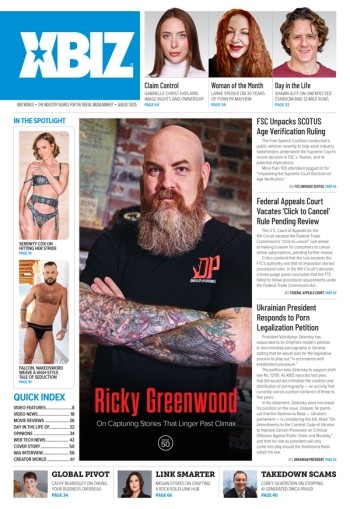The more things change, the more they stay the same, at least when it comes to the manufacturing and marketing of fetish products.
With modern technological advancements and continually shifting sands of cultural acceptance, how manufacturers and sellers of fetish products — a term which can encompass a wide range — has evolved and continues to evolve but not, perhaps, as much as you might think.
Being interested in sexual fetishes was “pretty much a hush-hush kind of thing” until about eight or nine years ago, it was not something you’d see in mainstream media. It’s become more and more acceptable. -Andy Ptashnik, Rapture Novelties
The market for fetish products is as diverse as the products themselves, from anatomically correct whale penises to leather gear that might be sold at a Renaissance faire. And while the “Fifty Shades of Grey” phenomenon may have brought in some dollars into the industry, most marketers and manufacturers of fetish products don’t see it as having a lasting effect.
Justin Sayne, of Justin Sayne Leather, said the industry has not changed much at all, in any profound ways, since he started making hand-made leather adult products five years ago.
“I’ve not seen anything change for a long, long time, except for the materials and the delivery,” he said. “‘Fifty Shades,’ it’s not about our lifestyle, it’s not about what we do. It will leave a few players and the rest of them will bounce.”
That being said, “Everyone’s seen a bump from the ‘Fifty Shades’ phenomenon,” according to Brian Sofer of Pipedream.
“Pipedream experienced a lift in 2012 for sure and because of our dominance in the fetish market, continue to enjoy that lift today,” he said.
The difference, according to Andy Ptashnik of Rapture Novelties, is the level of cultural acceptance. Ptashnik has been involved in the fetish world for “many, many years,” both as a manufacturer of products and a video producer.
Being interested in sexual fetishes was “pretty much a hush-hush kind of thing” until about eight or nine years ago, Ptashnik said. “It was not something you’d see in mainstream media. It’s become more and more acceptable.”
“We can say that there is a tremendous upsurge in fetish-type of activities and the subject in general,” he said. “This ‘Fifty Shades of Grey’ phenomenon allowed people who viewed fetish as a bad thing to view it as something that might be played with or talked about.”
However, Ptashnik, like Sayne, is not too sure that the cultural awareness and acceptance that resulted from the books by British author E. L. James and wildly popular movie adaptation has resulted in any real economic boost.
Rebecca Weinberg, project development/key accounts manager at manufacturer XR Brands, said the result in sales from the popularity of the movie, “wasn’t huge like the book,” perhaps because “reading a book you get to explore your imagination more.”
“The whole industry was out of stock on Ben-wa balls,” she said. “You couldn’t find them anywhere. “ Weinberg, like Ptashnik, sees little to no difference in how the heavier, harder fetish products are selling, while “more and more retailers are putting in a fetish department” to attract the weekend warriors.
If so, Hudsy Hawn is fine with that. As headmistress for Stockroom, Hawn said she sees herself as a “fetish advocate,” and often works with meat-and-potatoes married executives looking to spice up their marriages with a little fetish play.
“There were the people who were drawn to it because it provided a healing for a past history experience,” Hawn said of the BDSM lifestyle.
But if “Fifty Shades” did anything, it was make bondage and discipline an acceptable fantasy, allowing users to take a stab “without being so afraid,” according to Hawn.
“That book is acting as a permission slip,” she said. “It’s not exactly BDSM, it’s like BDSM lite.”
Hawn, too, sees a difference in the level of involvement. People new to the fetish world are interested in learning how to convince their significant others to get involved, and Stockroom’s sales are bearing that out. Hawn said her company has seen an uptick in the mini hand-held floggers, blindfolds, feathers, candle wax — what she called “the early beginning props.”
There have been more requests for education and information, but “I don’t think a million people are going out and buying a Sybian machine,” she said.
“Fetishes are definitely more acceptable now and pop culture can’t seem to get enough of them — art is only a reflection of life,” according to Pipedream’s Sofer.
“Pop culture has obviously embraced it as ‘Fifty Shades of Grey’ illustrates,” he said “BDSM purists can bicker over whether or not the movie is truly fetish or not. Who cares? It created tremendous opportunities and profits for our industry by exposing BDSM products and more broadly, all pleasure products — to a new and untapped market.”
But, again, the old standard realities of sales have not changed. Companies still must market to a variety of consumers in a variety of ways. Pipedream, for example, has seen success in both the traditional and digital marketplace.
“It really depends on the product and the type of consumer or fetishist someone is,” Sofer said. “Some folks like to get into a store to feel the material of the restraints, others like the anonymity of online shopping for products they may feel uncomfortable buying in person.
“Consumers are becoming more and more exposed to outside of the box, missionary alternative sex every day,” he said.
As exciting and risqué as the fetish business might be, mundane, seemingly commonplace concerns like quality and price point still remain at the top of a customer’s priority list.
Sayne of Justin Sayne Leather tends to market directly to the consumer, going to shows and festivals and, while “the bulk of the product is coming from Asia,” he sees the market for hand-tooled leather as strong. He’s seen a lot of success with a latigo flogger “that seems to be the right price point.”
“You can buy a quote unquote quality product, in a lot of situations,” he said. “Is it a high-quality, hand-made, guaranteed-for-life piece? No.”
Larger companies like Pipedream have seen the same demand for quality and cost-effectiveness. Their Fetish Fantasy Gold collection has been a top seller, Sofer said, because it seemed to meet both of those requirements.
The gold had better hardware and was able to meet the demands of consumers looking for high-quality fetish product at a good price,” Sofer said.
Of course, any item themed “Fifty Shades of Grey” has seen significant sales in recent years, again, among the less experienced customers.
“I did notice some of our bondage items were sought after,” Weinberg of XR Brands said. “The actual ‘Fifty Shades’ brand did a lot of the business.”
Sofer concurs. “Certainly any of our Fifty Shades of Grey themed products from the Fetish Fantasy Limited Edition collection all continue to be strong performers,” he said.
The most exciting changes to the fetish industry may yet be on the horizon.
Sofer said his research and development department is “constantly working on setting the next trend and bringing our customers the latest innovations in pleasure.”
Weinberg, who noted that “the toy business is definitely changing every year,” said she is working with an anonymous venture capitalist to create augmented reality goggles, “mind-control stuff” she said is “years away.”
In the meantime, users interested in advanced technology will have to content themselves with iPhone apps.
“You can wear one of those vibrating eggs in your panties and your partner can vibe you from anywhere in the world, that’s already happening,” according to Hudsy Hawn of Stockroom. “The key to success is diversity and versatility. As long as you stay in the know it all just kind of works itself out.”
But the more things change, the more they stay the same. Manufacturers of steel and leather products, like Rapture and Justin Sayne, are putting modern spins on products that have been available for thousands of years.
“We have new product coming out all the time. Variations of existing products and new products with different styles and colorings,” Ptashnik said. When asked if he was planning to offer a toy that can be used with an iPhone app, he said Rapture’s business model doesn’t require it.
“We don’t have any immediate intentions of moving in that direction,” he said. “Our manufacturing infrastructure is designed to produce stainless steel.”
Sayne said several of his products have changed very little, though he said he’s “tried to reinvent the same old, same old,” like an alligator whip the derivation of which is readily obvious.
“You can totally look at it and see where the standard 10,000-year-old whip influenced that,” he said.







